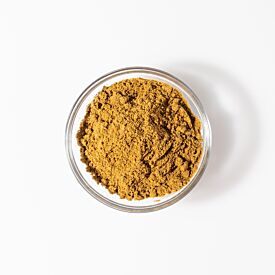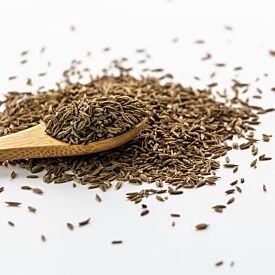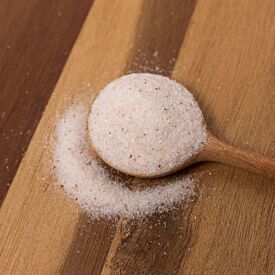Seasonal Recipe: Curried Yam & Toor Dal Soup
When I hear fall, the foodie in me says soup. Creamy soup, chunky soup, brothy soup, any type of soup will do. As long as it’s warm, a bit herby, and spiced with a whole lot of love, I am in!
With temperatures dropping and leaves turning, soup is taking a prominent seat at the table. Gracing magazine covers to Instagram feeds, soup season is upon us. What may seem like an obvious seasonal choice today, likely has a story connected to resources, sustainability, and health.
Not knowing enough about food history to speak about this cold-season ritual, I refer to Ayurveda. Specifically, I refer to the the qualities, or gunas, and their actions and energies, to understand why soup is nourishing goodness for the fall season.
The 20 gunas describe each of the six tastes along with the feeling, texture, and action an ingredient or dish will have on the body-mind. Becoming familiar with the gunas and the six tastes is a simple, yet insightful tool for preparing or choosing a balancing meal for one’s current state of balance (vikriti) and to align with the season. If you are unsure of your vikriti, take the Ayurvedic dosha quiz.
Generally speaking, fall soups have four main qualities—liquid, moist, warm, and heavy. Whether a recipe calls for water, broth, or some form of cream, soups tend to be rich in the element of water, which is naturally heavy, liquidy, and moist.
Depending on the type of soup, the level of heaviness can vary and will determine how a dish will engage with the body-mind. For example, brothy soups tend to be clear, lighter, and hydrating, and thick cream-based soups will be richer, heavier, and grounding.
What is important to note is neither type of soup is good nor bad, they are just different and each can have all six tastes. The ingredients used in the soup, and the current state of the person enjoying the bowl of warming goodness, can provide greater details on how the soup will digest, absorb, and assimilate.
Balancing the Qualities
The story of balance begins to unfold further when we compare soup’s general qualities of heavy, liquid, moist, and warm to the cold, mobile, light, and dry qualities of fall, or vata season.
A key concept in Ayurveda is counterbalancing, or like attracts like and opposites balance. This concept further helps determine what is appropriate to eat.
In the fall, when vata dosha is prominent in our external environment, counterbalancing fall’s qualities with food’s qualities is a one form of self-care. Soup’s liquid and moist quality can support the season's dry quality, and the warmth will counterbalance the cold temperatures. The heavy quality of a soup can ground the light and mobile qualities of the season.
If you know what qualities of vata dosha tend to go out of balance within you, choosing food or adjusting recipes become easier. Simply picking ingredients or dishes with opposing qualities will help bring balance.
For example, if you tend to run dry and feel lethargic, a moist, brothy soup could be a healthier choice than a heavy creamed soup as a brothy soup will be less clogging and heavy on the channels. Additionally, a lighter and clearer brothy soup will be hydrating and easier for the body to digest.
Another option could be to lighten a creamy soup by adding more water and, instead of cream from nuts or dairy, cream a vegetable like cauliflower. Adding warming digestive spices such as cumin can boost digestion and is not as drying as a large dose of black pepper.
By knowing the qualities of my own constitution, or prakriti, the fall season and soups have shifted my understanding of healthy. Focusing on a meal’s qualities (and tastes) has helped guide my choices and strengthen my inner wisdom, reminding me to think about the digestibility factor.
It is liberating to interpret and explore how food’s qualities will engage on my physical, emotional, and mental levels; and choosing the right ingredients is a simple way to deepen and broaden my understanding of what is healthy for me. This makes it easy to appreciate soup’s nourishing fall goodness!

About the Soup
This recipe is inspired by toor dal, a pulse (dried, edible bean from a pod) that is one of my all-time favorites. Called pigeon peas in English, they have a flavor all their own, and together with ghee, they are forever infused in my thoughts.
This legume does not often get the attention it deserves. One reason could be the time it takes to cook them; however, the flavor and nutrients are worth it. And with a good soak or a pressure cooker, they’re ready to eat in no time at all.
What I love about this recipe, aside from the sweet, slightly-tart experience, is how it easily transforms from a creamy, heavy soup to a light dal, which can then be served over your favorite grain, perhaps with a veggie or a freshly made relish to add an array of qualities.
Curried Yam & Toor Dal Soup
Ingredients:
- ½ cup toor dal soaked (30 minutes to overnight)
- 1 medium yam or sweet potato, peeled and chopped
- 4 ½ cups water or broth
- 1 inch peeled, chopped fresh ginger
- 1 teaspoon toasted coriander powder
- ¼ teaspoon toasted cumin powder
- 1 tablespoon jaggery or sucanat
- ½ teaspoon turmeric powder
- ¼ teaspoon asafatoedia (hing)
Tempering
- 1 tablespoon of ghee or coconut oil (solid)
- ¼ teaspoon brown mustard seeds
- 1 teaspoon cumin seeds
- 4–6 curry leaves
- 1–2 cloves
Finishing
- 1 teaspoon salt
- Juice of 1 lemon or lime
- ⅛ cup chopped finely chopped cilantro including stems
Directions:
Add soaked toor and water to a 4-quart pot, cover, and bring to a simmer. Remove foam, then add ginger, coriander, cumin, jaggery, turmeric, and hing. Add the yams, and continue to simmer covered until toor dal begins to break down. Depending on how long the dal was soaked, this could take 30 to 60 minutes.
Add salt, then blend with a hand blender or blender until smooth. Return to pot and bring to a simmer.
In a smaller pan, warm the ghee on medium to medium-low heat. Add the mustard seeds and saute until they start to crackle, releasing their essential oil. Next, add the cumin seeds and cloves. Cook until the cumin seeds are toasted and the ghee is fragrant. Add curry leaves and stir. Immediately add to the dal and cover for a few minutes.
Stir and ensure the thickness is of a desired consistency. If more water/broth is needed, add it now and bring to a simmer. This soup can be served thick and creamy or lighter and more liquidy. Before serving, stir in the salt, lemon or lime, and cilantro. Taste and adjust, if needed.










